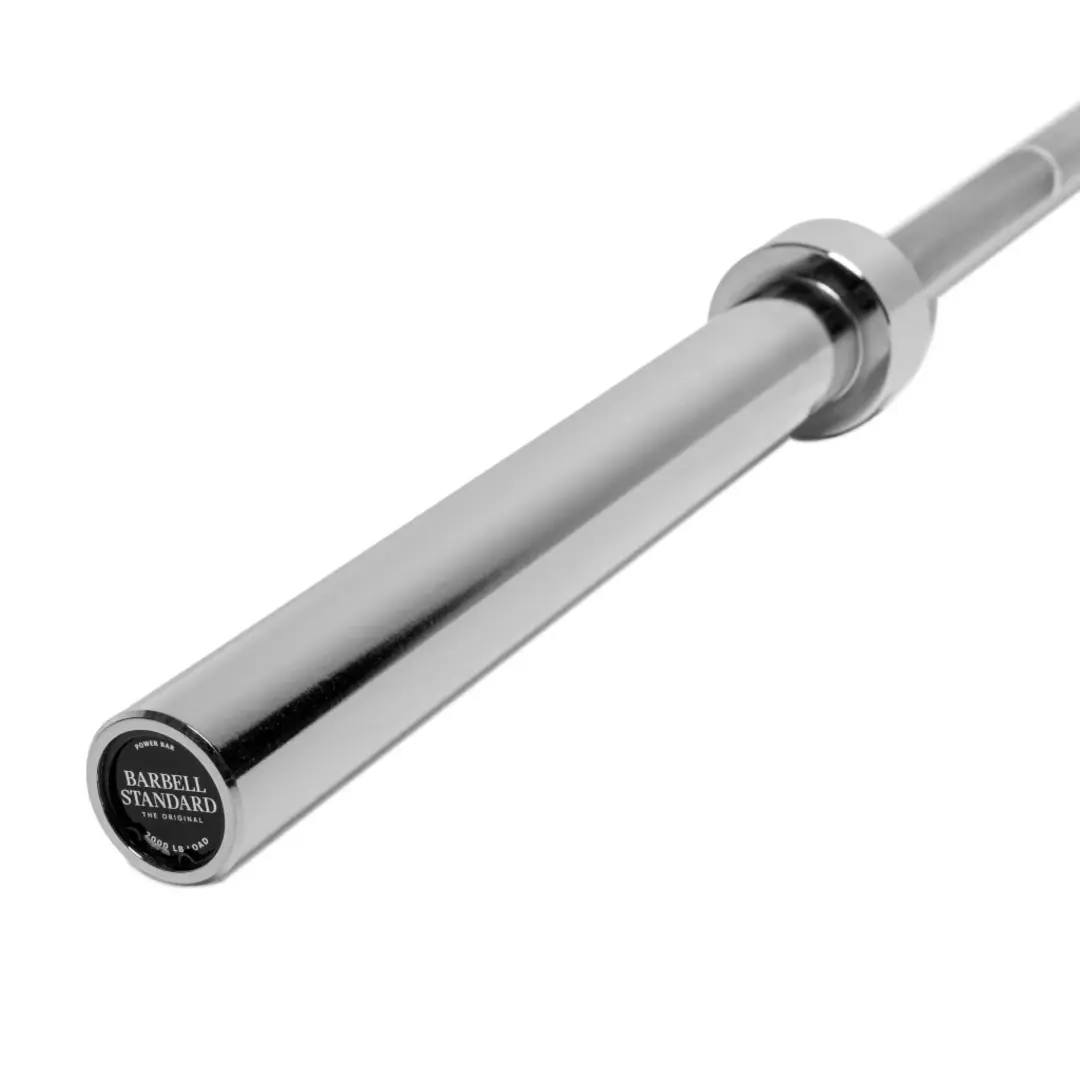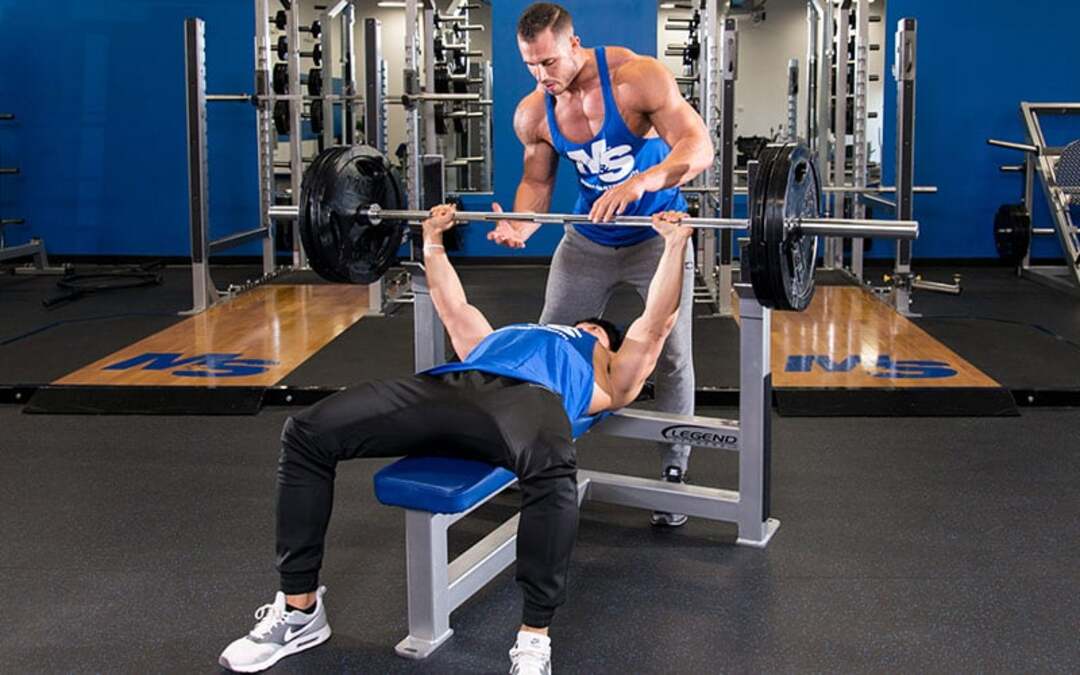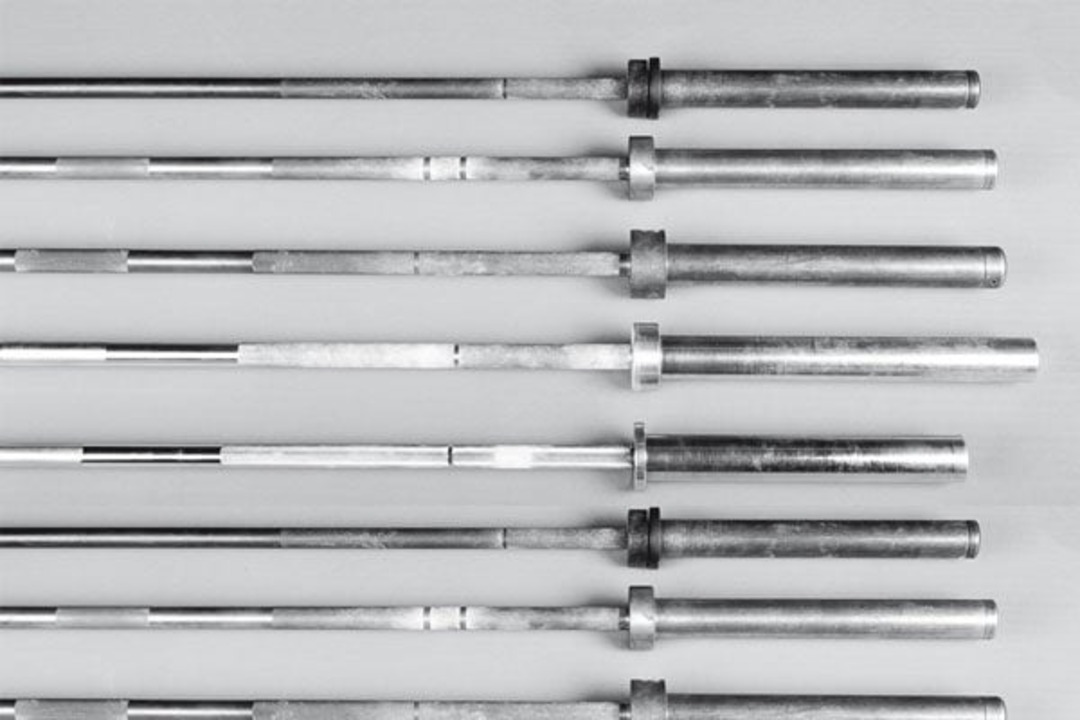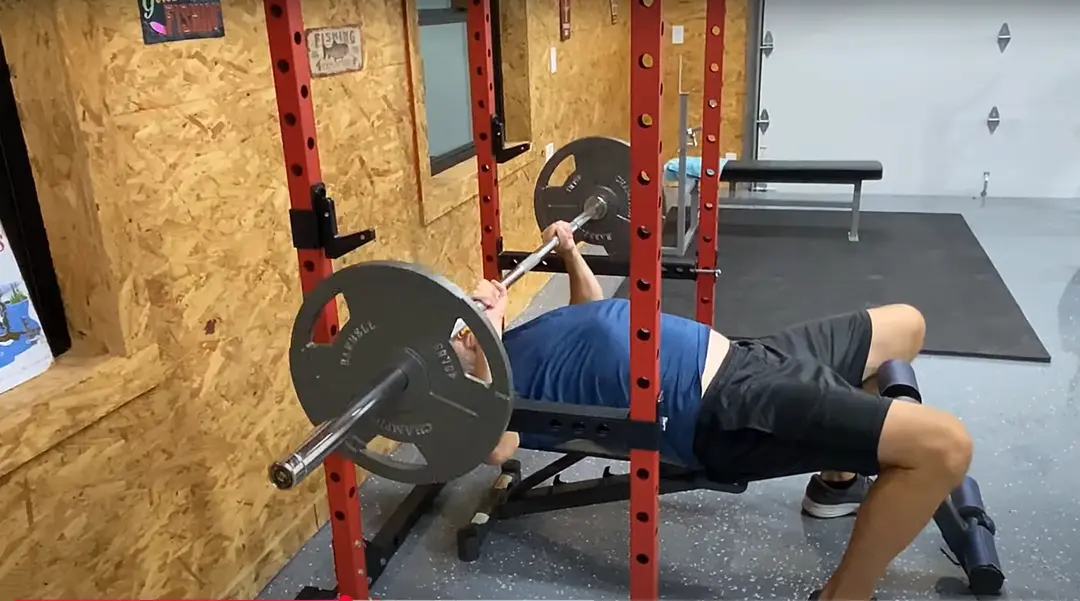How Much Does A Bench Press Bar Weigh?
.jpg)
Curious about how much a bench press bar weighs? Learn the exact weights for standard, Olympic, and specialty bars before your next lift.
If you use the Best Fitness Apps to log workouts, have you ever wondered whether the recorded 45 pounds includes the bar or just the plates? Barbell weight matters — from a 20-kilogram Olympic bar to a standard 45-pound power bar, a woman's 35-pound bar, an EZ curl bar, or a fixed weight bench bar — for accurate reps, sets, and progressive overload.
This guide provides exact weights for standard bench press bars and covers plate weight, sleeve and shaft differences, knurling, and length so that you can track lifts exactly and plan strength training.
GetFit AI, an AI fitness app, puts bar specs, a quick weight calculator, and automatic plate math into your training log so you record actual load, compare sessions, and plan steady progress.
Summary
- Bar weight matters for accurate progression; a standard bench press bar typically weighs 45 pounds, and leaving that out skews reps, sets, and percentage-based programming. And this is where GetFit AI fits in: it auto-includes bar specs and automatic plate math in your training log, so recorded load equals actual load.
- Different bar types change how a lift feels and how you should program it. Olympic competition bars are 20 kg, while Swiss bars range from 15 to 25 kg, and the whip or sleeve design alters timing and load distribution. GetFit AI addresses this by detecting bar type from a photo or input and applying the correct bar weight and sleeve considerations to logged lifts.
- Relative strength is a more meaningful benchmark than raw numbers. A good bench press guideline is about 1.5 times bodyweight, while the average male bench press is around 217 lb. This is where GetFit AI fits in, mapping program phases to the athlete’s age and bodyweight so prescribed loads match the lifter.
- Simple, specific testing avoids expensive mistakes, evaluates an unfamiliar bar across three sets at 60 to 70 percent of planned top work to check feel and joint response before committing a training block, and GetFit AI addresses this by suggesting initial test sets and flagging inconsistencies or pain across sessions.
- Accessories must be programmed, not tacked on; most templates use accessory work 2-3 times a week. Bands are often prescribed as 3 sets of 10 to 15 reps to build timing and lockout, and this is where GetFit AI fits in, recommending accessory frequency and specific tools based on planned intensity and recovery metrics.
- Minor measurement errors compound across training cycles, so plan in defined 6- to 12-week blocks with clear markers, like increased reps at a fixed weight or cleaner technique. GetFit AI addresses this by integrating bar specs, sleeve notes, and plate math into block planning, ensuring percentage-based progressions remain accurate.
How Much Does A Bench Press Bar Weigh?

A commercial bench press bar is almost always treated as a fixed baseline weight, and that baseline is the bar itself, not the plates you add. According to Major FitHealth.com, a standard bench press bar typically weighs 45 pounds; that figure refers to the bar alone and is the reason many gym logs default to that baseline.
Why does the bar weight actually matter when you track lifts?
Because the bar is part of the load, failing to account for it skews your training numbers and progression. This plays out practically: lifters report stalled progress or false personal records when they forget the bar, and coaches spend sessions correcting math instead of refining technique. If you want precision, treat the bar like the vehicle’s curb weight, and the plates as the cargo you add on, because minor errors compound over weeks of sets and reps.
How do you check a bar’s actual weight?
This challenge appears in both commercial and home gym setups, where bars sometimes lack markings or vary by type, so the reliable moves are simple—look for stamped weight, ask gym staff, or place the bar on a scale if possible. That last step removes guesswork quickly, and it’s why experienced lifters will weigh unfamiliar bars before chasing percentage-based training for a block of sessions.
What variation should athletes expect between bars?
There are lighter techniques and specialty bars for rehab or youth work, shorter bars for smaller athletes, and the full-length commercial bars that most programs rely on. Even aggregated equipment references like Setgraph, Which Show That Most gym barbells weigh 45 lbs, reflect this industry tendency to standardize on a single baseline, which helps when you move between gyms but hurts you if you assume every bar is identical.
Most teams track weight by hand because it is familiar and fast. That works when you train casually, but when you scale volume, use percentage-based programming, or follow celebrity routines that demand exact loads, manual checks become error sources: session logs diverge, plate math gets messy, and recovery estimates drift. Platforms like GetFit AI find that friction and address it by detecting bar type from user input or photo, auto-including bar weight in logged lifts, and flagging inconsistencies, so athletes preserve training fidelity without extra admin.
A small, specific habit prevents mistakes: mark bars you own or use regularly and confirm any unmarked gym bar with a quick scale measurement before starting a new block of work. That single discipline saves wasted weeks of miscalculated progress and keeps your technique work honest.
That apparent neatness in bar weights looks solved, but the moment you layer age, experience, and program specificity onto it, unexpected problems emerge.
Related Reading
- Best Fitness Apps
- How Many Pull Ups Should I Be Able To Do
- Average Bench Press By Age
- Average Grip Strength Male
- Average Bench Press
- Average Male Bench Press
- How Much Can The Average Man Bench Press
- Grip Strength Chart
What is the Average Bench Press Weight for Teenagers?

Teen bench press numbers swing widely because age, bodyweight, and training history matter more than calendar years. Rather than memorizing a number, judge progress by how a teen moves against their own bodyweight and technical consistency.
How should you judge a teen’s bench press progress?
When we built seasonal plans for young athletes, the pattern became clear: beginners need a base phase, then a measured transition to higher-intensity templates. Start with simple, repeatable lifts and track load relative to bodyweight and rep quality. Programs that emphasize steady progression, like beginner linear routines followed by more structured systems, produce the most dependable gains because they prioritize technique and recovery over chasing a poundage headline.
What role does relative strength play for teens?
Use relative strength as your compass. According to, A good bench press for a male lifter is 1.5 times bodyweight. Strength Level, 2023 frames that ratio as a practical benchmark for comparing strength across different bodyweights, and it is far more meaningful for teenagers than raw totals. Conversely, to see where adult populations sit, note that the average bench press for a male lifter is 217 lb. Strength Level, 2023, compiled the average across adult lifters, which should not be treated as a default teen target.
Which factors push a teen above or below the average?
Growth spurts, hormonal timing, and the amount of structured training a teen has done explain most of the differences. Neuromuscular coordination and tendon resilience lag behind muscle size for many adolescents, so a heavier-looking kid may not press proportionally more at first. Training history matters: consistent twice-weekly benching with progressive overload yields steady improvement, while sporadic sessions create stalls and frustration.
Why copying celebrity routines fails teenage athletes
Most teens mimic advanced athletes because it feels exciting and concrete. That familiar approach works emotionally, but the hidden cost appears when loads are scaled incorrectly, recovery is ignored, and technical gaps widen. Platforms like GetFit AI provide an alternative path, mapping program phases to the athlete’s actual age, bodyweight, and bar type so that prescribed loads fit the lifter—not a heuristic copied from a video—which keeps progression consistent and reduces needless setbacks.
How do you set safe, measurable targets for a training block?
Think in blocks of 6 to 12 weeks, with clear performance markers: steady increases in reps at a fixed weight, cleaner technique under load, and fewer technique regressions on heavier singles. Begin with foundational sets focused on form, add accessory work for shoulder and scapular health, and only raise top-end intensity after movement stays clean. That method keeps training honest and reduces the emotional churn of chasing fast gains.
The most straightforward analogy I use with teens is this: strength is a house, not a sprint; you need a level foundation before you can add floors without collapse.
That predictable-sounding plan still leaves a surprising set of choices every coach must make next.
Related Reading
- Bench Press Standards
- Do Pull Ups Work the Chest
- Symmetric Strength
- Grip Strength Norms
- Average Deadlift Weight
- 1 Rep Max Chart
- Average Male Deadlift
- Good Bench Press Weight
- Weightlifting Standards
Types of Bench Press Bars

There are distinct bench press bars built for different goals: some prioritize stiffness and maximal loading, while others adjust hand position to protect the shoulders or shift emphasis to the triceps. Pick the bar that matches the movement pattern you need, not the one that looks heaviest on the rack.
How does bar flex, or “whip,” change my lifts?
Bar flex alters timing and feel. A bar with more whip stores elastic energy as you drive it off the chest, which can help faster lifters during lockout, but requires tighter technique; a stiffer bar demands more raw force throughout the press. Think of it as swapping between a springy rope and a solid pole, the same motion but different skill and timing required to get the load moving.
Which bars actually reduce shoulder pain while keeping load?
Neutral-grip, multi-grip, and Swiss-style bars reduce internal shoulder rotation and shoulder torque, making them the safe choice when inflammation or impingement occurs. The Swiss bar typically weighs between 15 and 25 kg, as noted by Powerlifting Technique, which matters when you program percentages or compare volume across bars because the bar alone can change your session load. In practice, athletes who shifted primary bench work to a neutral-grip bar during an eight-week block held training volume and reported less sharp shoulder irritation, allowing consistent progression without forcing technical regressions.
What do bar diameter and sleeve design mean for loading and plates?
Bar diameter and sleeve construction determine grip comfort and plate compatibility. Competition Olympic bars are built to handle heavy, dynamic loads, with men’s competition bars set up as a heavy-duty option: Powerlifting Technique reports the standard Olympic barbell weighs 20 kg, which influences how coaches write percentages and how lifters plan jump plates and warmups. If your gym’s sleeves wobble or the bar spins poorly, it changes the bar path and can turn a good set into a grind that exposes weaknesses in technique rather than strength.
Most people pick a bar because it is immediately available, and that works for casual sessions. The hidden cost appears when you follow percentage programming, rehab an injury, or chase a celebrity routine without adjusting equipment: misaligned bar choices fragment progress, raise injury risk, and turn clear plans into confusing guesswork. Solutions like an AI fitness app detect the bar type from a photo or input, auto-apply the correct bar weight and sleeve considerations to your logged lifts, and suggest alternative bars or adjusted loads to improve training fidelity without extra bookkeeping.
Which specialty bars change muscle emphasis the most?
Cambered or curved bench bars increase range of motion and load the pecs differently, making them helpful for hypertrophy blocks but requiring extra shoulder and scapular control. Multi-grip bars concentrate tension through triceps and reduce pec flare, which can be a deliberate choice during a heavy press block where shoulder recovery matters more than chest stretch. The tradeoff is always the same: pick the tool that lets you complete the intended adaptation without introducing compensations that mask a weakness.
Simple testing rules that actually work
Test a new bar across three sets at 60 to 70 percent of your planned top work, note how the joint feels and how the bar tracks, then adjust volume or pause if pain or instability appears. It is exhausting when equipment quirks steal weeks of training and force technique back to square one, so treat bar selection like minor equipment tuning, not an afterthought.
Ready to train like the legends and finally achieve the body you've always wanted? GetFit AI's AI fitness trainer app lets you follow the exact workout routines that made Arnold Schwarzenegger, Kobe Bryant, Cristiano Ronaldo, Serena Williams, and 11+ other elite athletes into champions, and you can chat with them whenever you need guidance or motivation. Download the #1-rated AI fitness app for free today to get fit for less than the cost of a single month's gym membership, because greatness isn't born —it's built one workout at a time.
That change in equipment feels small until you realize it alters everything about how a program actually runs.
How To Choose A Bench Press Bar

Match the bar to the exact demands of your program and to how your hands, shoulders, and nervous system tolerate load. Look beyond advertised weight to shaft diameter, knurling, sleeve design, material, and rated capacity, because those factors change how the bar feels, how safely you can progress, and how consistent your numbers will be.
How wide should the shaft be for my grip and program?
If you train for heavy singles and tight control, a thicker shaft feels more secure and reduces forearm flex, but it raises the grip demand. If you do higher reps or lack maximal grip strength, a narrower shaft preserves bar control and reduces early fatigue. This pattern appears across garage setups and commercial gyms. When athletes graduate to thicker competition bars without targeted grip work, their top-end lifts stall until they add specific grip volume or switch back temporarily. Think of shaft diameter like shoe width, not shoe size; the wrong fit changes your whole movement.
What should I read about knurling and center knurling choices?
Knurling is where preference meets consequence, because aggressive knurling gives confident purchase but chews skin and increases local soreness during high-volume phases. Center knurling is useful for squat stability but can dig into the chest and interrupt the bar path on heavy benches. If your plans include long hypertrophy blocks or frequent pauses at the chest, favor milder knurling or tape the contact area to preserve consistent training without frequent flare-ups or scapular tension.
Why do sleeve system and loadable length matter for long-term progress?
Sleeve length controls how many plates you can load and thus whether the bar will support heavy top sets. Bearings versus bushings change sleeve spin, which affects dynamic lifts and how the bar feels during explosive transitions. For smaller home rigs, note that a standard barbell is usually 5 to 6 feet long and weighs between 15 and 25 pounds, which directly limits plate capacity and alters how you plan progressive overload and jump plates. Choose a bar whose sleeve length matches the expected peak loads you will chase, not just the loads you lift today.
How should body size and gender influence your bar selection?
Bar length and mass matter for fit and symmetry, especially when shoulder width and limb length vary. For many female athletes and smaller lifters, a shorter, lighter Olympic option improves setup and reduces compensatory shoulder torque, because the bar sits within a more natural hand path. For context, a women's Olympic barbell is typically 6.5 feet long. It weighs 35 pounds, and choosing that option can cut awkward wrist angles and let you focus on pressing mechanics rather than force the shoulders into workarounds.
What material, tensile rating, and finish should I care about?
High tensile strength means the bar resists permanent bend when loaded repeatedly, which matters when you plan heavy cycles or travel between gyms. Finishes change maintenance and feel: stainless resists rust and needs less care, while chrome or black oxide will require regular wiping in a humid space. When buying used, check for sleeve wobble, uneven knurl wear, and rust at the shaft-sleeve junction, because those defects degrade safety long before they change how heavy the plates read.
Most lifters just grab the rack bar because it is familiar and fast. That works at first, but as you layer programming complexity, small mismatches compound: grip fatigue, subtle shoulder irritation, and inconsistent bar spin turn neat plans into months of chasing variables instead of strength. Platforms like AI fitness app detect the bar type from a photo or input, apply the correct bar weight and sleeve notes to your logs, and suggest alternative bars or adjusted loads. Hence, training fidelity stays intact as you scale volume and intensity.
How do I test a bar before committing to it?
Check three things in one short session, in this order, and you will learn what the bar demands: load moderate plates and press to evaluate wrist alignment and chest contact; rack the bar and inspect sleeve runout by slowly rotating a plate looking for wobble; and run a few sets with varied grip widths to see if knurling or diameter forces technique changes. If any check produces persistent pain or instability, that bar will cost you training weeks, not just a session.
Choosing the right bench press bar is a small decision that changes practice, not just numbers.
The twist nobody expects shows up when you add the rest of your kit.
Other Accessories to Improve Your Bench Press

Accessories are not cosmetic add-ons; they tune how the bar moves through your body and how much work your nervous system can handle. Use each piece to solve one problem—stability, wrist alignment, variable tension, or grip protection—and program them into your block with the same precision you give your bar and plates.
When should you put on a weightlifting belt?
A belt raises intra-abdominal pressure so your torso holds steadier under heavier loads, which matters when a single failed tightness pattern costs a weekly PR. Use a 4-inch belt for benching, set it where you can brace the ribs and lower belly, and reserve it for top sets or heavy triples rather than every warmup. When coaches hand out the same belt rule to everyone, the hidden cost becomes apparent: athletes either become dependent or never learn tightness cues. After working through an eight-week competitive block, the pattern became clear: generic belt prescriptions often masked technique gaps that only surfaced when the loads climbed.
How tight should you wrap your wrists, and when?
Wraps are a mechanical shortcut for wrist extension control, not a substitute for forearm strength. Tighten them so the wrist sits neutral under load, firm enough to prevent collapse but loose enough that the hand still senses the bar. Use wraps for heavy doubles and singles where wrist collapse would short-circuit the press, and skip them for volume days that build tendon resilience. Think of wraps as a steering damper on a heavy truck; they stop the steering from flopping when you hit a pothole, but you do not want that damper engaged for every commute.
How do resistance bands change the stimulus?
Bands add variable resistance, shifting demand toward lockout and forcing stabilizers to work differently across the range of motion. Use them both for targeted warmups and for accessory lifts like banded triceps pushdowns, band pull-aparts, and banded presses, programmed as 3 sets of 10-15 reps, Seriously Strong Training, to build repeated tension without grinding the joints. Anchor the bands safely, test small increments of tension, and treat their feedback as information about timing and lockout, not just a way to make the set harder.
What role do gloves and shoes play in benching?
Gloves protect skin and improve grip comfort during high-rep or conditioning blocks, while bench-appropriate shoes give a firmer, non-compressible base for leg drive. Choose thin-palm gloves with secure wrist straps when blisters or long sessions are the limiting factors, and prioritize a flat, stable sole on shoes so force transfers predictably from the feet through the hips to the bar. If you make footwear and gloves afterthoughts, you accept small inefficiencies that add up across heavy training cycles.
Most lifters default to whatever kit is on the shelf because it is familiar and fast, and that works at low volume. As training complexity grows, that familiar approach fragments progress: accessory choices conflict with program goals, recovery calculations drift, and technique problems hide under generic templates. Solutions like GetFit AI identify your bar type, planned intensity, and training phase, then suggest specific accessories, set-rep targets, and timing adjustments; teams find that automating these choices preserves consistency as volume and specificity increase without adding extra planning overhead.
How often should you schedule accessory work in a block?
For most strength or hypertrophy phases, Seriously Strong Training recommends training accessory movements 2-3 times a week to balance stimulus and recovery across microcycles. Practically, place one focused accessory session after a heavy bench day and another lighter, technique-oriented session later in the week, adjusting load if fatigue accumulates.
Which accessories should you prioritize, and how should you rotate them?
Pick two to three accessories that target your weakest link that week, then rotate them across blocks. Example template: heavy bench work, then one pressing accessory for triceps, one horizontal pull for scapular balance, and a banded drill for lockout timing. If you follow cookie-cutter lists without measuring response, progress often stalls by week six. When we adjusted accessory selection based on weekly readiness scores and joint feedback, lifters maintained upward momentum without extra sessions.
That solution sounds tidy until you realize there is one persistent choice that still trips most athletes.
Make Your Favorite Athlete Your Fitness Trainer | Try GetFit AI's AI Trainer App for Free Today 💪

It’s exhausting when a "free lifetime" promotion shows one thing but the billing flow only lists monthly or yearly options, because that mismatch erodes the confidence you need to follow a precise, athlete-level plan. If you want coaching that translates exact bar, sleeve, and plate details into safe, personalized workouts, consider GetFit AI 80% of users reported improved fitness levels within 3 months of using GetFit AI, and 90% of users recommend GetFit AI to their friends.
Related Reading
- Average Bench Press By Age 16
- Best Free Workout Apps
- Best Calisthenics Workout App
- Average Deadlift Weight For Male
- Average Deadlift Weight Kg
- Best Workout Apps
- Best Hiit Workout App
- Best Workout Tracker App
- Average Bench Press Kg By Age
- Best Gym Workout App
- How Many Pull-Ups Can the Average Person Do
- Pull-Up Strength Standards
- Weighted Pull-Up Standards
- Weighted Dips Strength Standards
- Grip Strength Standards
- Average Dumbbell Shoulder Press
- Average Incline Dumbbell Press



.png)
.png)











